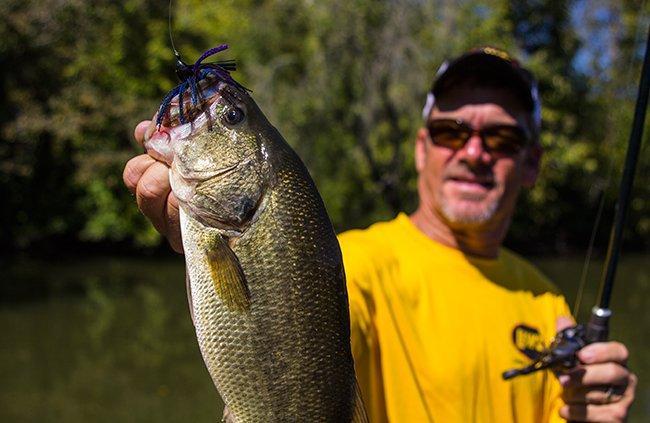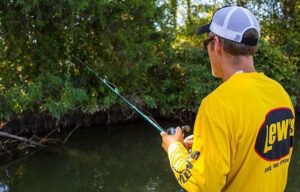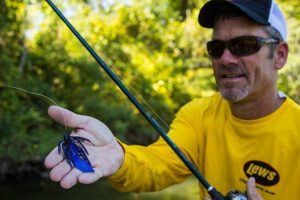Fall bass fishing can be a fickle and frustrating beast at times. When we find a big school of bass stuffing their guts with thousands of shad, it can be some of the most exciting action of the year. If both the bait and bass are scattered, however, we’re often left scratching our heads, pullling our hair and mumbling some not-so-nice words beneath our breath.
If you’re having trouble getting bites this season, consider targeting backwater sloughs. According to Elite Series pro Stephen Browning, these shallow areas play host to some giant resident bass and the ongoing shad migration further sweetens the deal.
Before you begin your dissection, it’s important to understand a few key aspects that will drastically shorten the learning curve and increase your chances of success.
It’s a one-and-done strategy
Backwater resident bass live their entire lives in a very small area— regardless of the time of year, weather conditions or water levels, they don’t go anywhere. While this may sound like a sure-fire way to catch consistent limits of quality fish, be careful not to get lulled into a false sense of security.
“Targeting resident fish in backwater sloughs is an excellent gameplan throughout the fall, but don’t take ‘em for granted,†Browning said. “These areas don’t replenish quickly, so once you stick one, the odds of catching that bass again are slim-to-none. If you’re a tournament angler, don’t expect to catch them on tournament day if you’ve already beat them up in practice.â€
- Shake ‘em off— When Browning is looking for these resident bass in practice, you won’t see him setting the hook. If he gets a bite, he’ll drop his rod tip, give the fish plenty of slack and attempt to take the lure away from the fish. Through decades of experience, he believes that as long as the hook doesn’t penetrate the bass’ mouth, he can to return to the area and catch it when it counts.
- Tread lightly—“If you’re sitting in your favorite recliner and somebody keeps thumping you in the head, you’re going to move to the couch,†Browning said. “It’s the same kind of deal with these resident fish. So if you’ve had a few bites in practice, just leave it alone and let it rest. When they get spooked or know you’re there, they can be impossible to catch.â€
Locate isolated cover
Although the sloughs adorned with loads of cover may look most appealing to anglers, the bass tend to disagree. If you can find an area with a few pieces of isolated cover, your chances of running across that monster bass skyrocket.
“An overabundance of cover can actually hurt the fishing in this situation,†Browning said. “If there are a bunch of laydowns from which to choose, it gives them more hiding spots and makes them more difficult to catch. Isolated cover, however, tends to concentrate the fish and make their locations more predictable.â€
- Look for channel swings— After years of water moving in and out of these sloughs, small channel swings are often created. As you’re fishing the area, make sure to pay attention to the banks. The steeper banks are often indicative of a nearby channel swing that provides bass with added security, more forage options and an excellent ambush point when they need to feed. If you can find a single, isolated piece of cover in these areas, you can expect a bite almost every time.
- Small depth changes— You’d be surprised by the difference a seemingly menial depth change can make. If you’re unable to find a channel swing in a particular slough, just a one or two-foot depth change can be enough to hold a big resident bass. Fancy electronics aren’t necessarily needed, either— a pair of polarized sunglasses can work wonders when deciphering such shallow water.
If they’re eating, you’ll know it
Unlike many bass fishing techniques that can require hours upon hours of re-rigging and head scratching before getting a bite, backwater bass aren’t shy. If they’re in the area, you’ll know in a hurry.
“It’s usually very easy to get these fish to bite,†Browning said. “That’s one of the reasons I love this strategy so much— you can cover water much more efficiently than you’d think. If you haven’t gotten bit within the first hour in a slough, that tells you they’re either not actively feeding or they may not be back there at all.â€
- The fall makes it better— These resident bass have been through this rodeo a time or two, so as soon as the water temperature drops and the days become shorter, they’re hard-wired to begin feeding in preparation for the cold winter. Compound this instinctual behavior with consistent populations of shad migrating into these sloughs and the resident bass show themselves quickly.
- Timing is everything— “Although they’re pretty easy to catch, it’s still fishing and timing remains a major factor,†Browning said. “If you’ve fished a textbook area like I described without a bite, don’t be afraid to come back later. There have been countless times I’ve totally whiffed on my first visit to a slough only to come back later and absolutely hammer ‘em. It’s all about catching them in a feeding mode.â€
- Make a milk run— Targeting the backwaters of your fishery can definitely be a numbers game this time of year. To put the odds in your favor, spend a few days finding several sloughs with favorable cover and depth changes. When the weekend comes and it’s time to go fishing, you can rotate between these areas and cover a lot of water. You might only catch fish in two out of ten sloughs, but they’re usually the “right†kind of fish.
Go into it with the right mindset
Throughout the fall, many anglers become frustrated by the lack of quality bass they encounter. It can be fairly common to catch dozens of fish in a single outing, but 3-pounders can be mighty tough to come by at times. Browning believes this backwater strategy solves this problem.
“It’s important to understand that these backwater sloughs provide you with an opportunity to catch some really big bass,†Browning said. “You probably won’t go out there and encounter non-stop action. I’m looking for eight to ten bites and I expect two or three of them to be good, quality fish. If you’re up north, you’ll be around a lot of 3 and 4-pounders and if you’re down south, it can even be 5 to 6-pounders.â€
Very resistant to challenging conditions
It never fails for bass anglers— the weather is beautiful all week while you’re stuck inside at work and when Saturday morning finally rolls around, a massive cold front smacks your favorite fishery in the face and the bass get lockjaw. It happens to everyone, but these shallow backwaters can be an outstanding remedy for tough conditions.
“I might be beating a dead horse here,†Browning said. “But these resident fish aren’t going anywhere! Mother Nature can throw the kitchen sink at ‘em and they’ll still hang around. So even though they may be a little tougher to catch, you’ll have the comfort of knowing you’re at least around good fish.â€
- Fluctuating water levels— When the water levels sporadically change, main lake bass can often seem just as confused as the anglers. But backwater bass don’t really seem to be bothered by it. They didn’t get big by being dumb, so they’ll be sure to select a home—or piece of cover—that’s stable in both high and low water situations. As long as the water covers they’re back, they’re fat and happy.
- Cold fronts— “If you can make yourself slow down during a cold front, you’ll still catch these fish,†Browning said. “These fronts will often make main lake fish change water columns, but that’s not the case here. The most effective adaptation is to change the weight of your jig. I’ve noticed they can get very picky about fall rate in these situations, so try a size heavier or lighter and you’ll figure them out quickly.â€
Gettin’ jiggy with it
Some fishing articles can be a bit laborious to read. If the technique being discussed has several different rigging options or requires special modifications, we have to bore you for a few paragraphs with a bunch of “tackle talkâ€. Fortunately, that’s not the case here. Browning primarily relies on a single lure for the bulk of his backwater fishing.
Browning’s favorite jig setup for backwater pitching and flipping
- Jig: 9/16-ounce Jewel Stephen Browning Magnum Casting Jig
- Trailer: Z Man Batwingz
- Rod: 7-foot, medium-heavy St. Croix Legend Extreme
- Reel: Lew’s Team Gold Speed Spool Casting Reel
- Line: 20-pound Gamma Edge Fluorocarbon
“If I’m fishing sloughs in the fall, I can just about guarantee you I’ll be flipping and pitching a jig,†Browning said. “That’s not to say you can’t catch them on something else, but over the years it has emerged as a major confidence bait for me.â€
- Better hookup ratio— If you’ve fought a bunch of bass on lures with treble hooks, you’ve probably lost your fair share— we all have. Jigs, however, offer a great hookup ratio which is essential when you’re targeting a finite population of bass. You’re not going to get many bites with this strategy, so perfect execution is hugely important.
- Thorough presentations— Backwater bass aren’t always likely to travel great distances for a meal, making precise, snag-free presentations imperative. Browning will make dozens of pitches and flips to a single target before moving on and the jig allows him to fish accurately, efficiently and quietly.
- Get down and dirty— “Because you’re not really making a bunch of long casts, using a jig allows you to beef up your tackle and get down and dirty with ‘em,†Browning said. “I’ll beef up my rod, reel and line so I can pluck those fish from the cover before they wrap me around a limb.â€
If you enjoy fishing shallow water, make sure to fish some backwater sloughs during your next fishing trip. While all the main lake fish are being air-raided by big, noisy shad-imitation lures, you’ll likely have some really nice bass all to yourself.












